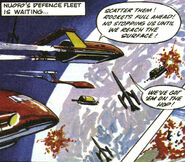A space bug or space wagon was a type of Federation auxiliary craft in service to Starfleet in the mid-23rd century. Several types of space bugs were manufactured.
Specifics[]
General purpose space bugs were instantly recognizable by their distinctive aft airfoil, small stabilizer wings and long duel rocket engine nacelles. Each had retractable, wheeled landing gear (1 front, two rear). The hatch could be locked with a security code. The ships were armed with missiles. Several of these vehicles were assigned to the starship USS Enterprise during the mid-2260s, and were given various assignments ranging from planetary exploration to aerial combat. (TOS comics: "The Crucial Element", "The Third Party", "The Children of Stai")
Two types of space bugs were built especially for combat. These were rectangular-shaped vessels having a narrow profile, three recessed aft engines, and a small glass dome on the top. Four of these vessels were assigned to the Enterprise early in 2266, three armed with phaser cannons while the other was designed for speed. (TOS comic: "The Eagles Have Landed")
Additional configurations of space bugs were customized for specific mission profiles. Some were constructed for spacecraft rescue or personnel rescue. Shuttlecrawlers combined flight operations with retractable, all-terrain ground propulsion. (TOS comics: "The Eagles Have Landed", "Target: Zargot", TAS novelization: The Eye of the Beholder)
Service history[]
In 2266, Hurst and his space bug crew were forced to cut short their exploration of Crucial III, hurriedly flying their space bug back to the shuttle bay just before the planet self-destructed. (TOS comic: "The Crucial Element")
Spock and three security officers took a space bug to the surface of the Mantis planet to rescue James T. Kirk and his landing party, who had been abducted by a long distance transporter and locked in a zoo. (TOS comic: "Beware the Beast")
When Kirk launched an assault on Nuofo, three space bugs, at least one exploration rocket, and three repair wagons were sent into combat against Nuofon spaceships. (TOS comic: "The Third Party")
Kirk visited Stai in a space bug, then later led a fleet of four space bugs to rescue Stai children held hostage by forces of the Galactic Union. (TOS comic: "The Children of Stai")
A group of Zond were captured after commandeering the Enterprise. They were sent into exile aboard a space bug. Rather than concede defeat, however, they used the vehicle's auto destruct system to commit suicide. (TOS comic: "Spectre of the Zond").
Space bugs[]
- General purpose bugs
- High speed bugs
- Combat bugs
- Limited purpose bugs
Background[]
| This section is written from the Real World point of view. |
- Space bugs were created for the UK comic strips series by writer Angus Allan and artist Harry Lindfield in 1969 to compensate for their lack of Star Trek reference material. Space bugs bore a passing resemblance to a ship from Gerry Anderson's Thunderbirds, a comic strip which accompanied Star Trek in Joe 90: Top Secret magazine. (See the Thunderbird 2 article at Fandom's Thunderbirds wiki)
- Space bugs were showcased in story arcs 2-5. Galileo (I) then appeared in two panels of arc 6. In arc 7, space bugs were drawn boxier and more closely matched the aesthetics of Galileo. The classic space bug was then bid farewell at the end of arc 8: it was launched into space and self-destructed in a metaphorical farewell. All subsequent auxiliary vehicles in the series were standard class F shuttlecraft.
- Artist Ron Turner featured space bugs in the series' first annual story, "Target: Zargot". One of the vehicles was outfitted with ground propulsion. Alan Dean Foster would use the term "shuttlecrawler" to refer to this type of craft in 1976, and FASA revisited the concept in 1987.
Images[]
Appendices[]
Appearances[]
- TOS comic: "The Crucial Element"
- TOS comic: "The Third Party"
- TOS comic: "Beware the Beast"
- TOS comic: "The Children of Stai"
- TOS comic: "Spectre of the Zond"
- TOS comic: "The Eagles Have Landed"
- TOS comic: "Target: Zargot"
- TAS novelization: The Eye of the Beholder
Reference[]
Connections[]
- See also: Repair wagon and exploration rocket.

